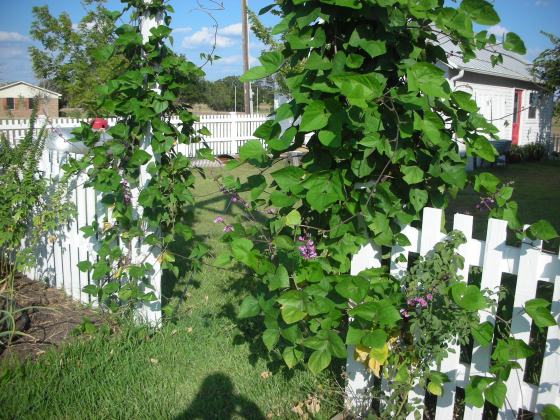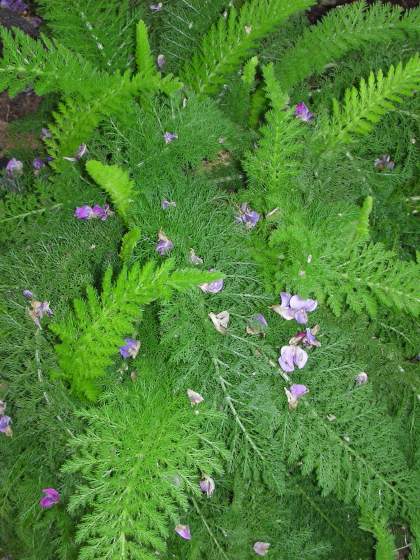This past spring I was at a garage sale at the home of a truly extraordinary horticulturist named Lorraine. She and her daughter hold this sale every spring. In addition to clothes and knick knacks, Lorraine sells plants. You never know what she is going to have. Many folks in town know that she can grow anything, so they bring her pots, seeds and cuttings. She always turns them into beautiful plants that she then sells at ridiculously low prices. She grows in compost that she makes herself. She has a green house, the cutest potting shed in town, and a dang fine vegetable garden that she has been tending in the same spot for over 60 years. She is truly incredible and I hope to someday be just like her. I really admire her and I never miss her sale. This year, she had three pots of hyacinth beans that I snatched up and took home. Those three little four inch pots of hyacinth beans have turned out to be the best $3 I have spent all year!
I planted Lorraine’s starts in May at the base of the trellis that leads to my side yard. This trellis is over 12’ at the top. I planted two plants on one side and one on the other. Since May, those three plants have grown and grown until they almost completely cover this huge trellis. The foliage is striking and the pinky-purple flower spikes are extraordinary. The bees, butterflies and wife love them.
Planting –Plant your seeds outdoors after all danger of frost has passed. You can also start them inside three or four weeks before the last frost. Some folks recommend pre-sprouting the seeds in damp paper towels before planting. However you get them to sprout, be sure and plant them in full sun. Hyacinth bean likes rich, well drained soil. Water regularly to get them established. Germination from seed can take about two weeks. Once the plant starts to grow, provide regular water but do not over water. They are relatively fast growing and should start producing flowers 45-60 days after germination.
My hyacinth bean bloomed for over a month before it set seeds. Maybe that was because it was just so hot. I saw my first flowers in July but I did not see my first seed pods until the first week of September. The plant is still blooming and it is beginning to get covered in the deep purple, iridescent seeds pods that it is famous for.
Hyacinth beans send out long runners that are perfect for quickly covering a fence, building or trellis. If growing on a fence, they need no support. To get mine to go up the trellis I tied the tendrils and shoots to the posts of my trellis using a jute-like twine. Once I had the vines trained over the structure I let them go. They soon sent out their long inflorescence of magenta flowers that make them so attractive. The posts of my trellis are 4 ½ feet apart. The inflorescences of these plants are now so long that you have to push your way through the flowers.
Harvesting – You can eat hyacinth beans if you harvest them when they are very young. Many cultures around the world use them extensively in their cooking. However, if you want to eat them you need to know that are slightly toxic when mature. So only eat them if you know when to pick them. In fact, once fully mature, they should not be cooked or ingested at all.
Hyacinth beans are fairly good re-seeders. Leave them alone and they will come back year after year. If you want to harvest the seed, wait until the plant has died and then pick the dry, brown seed pods. Once fully dry, open the seed pod and save the unique black seeds in a cool dry place until next spring.




